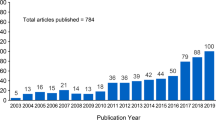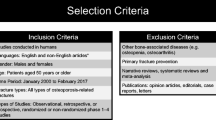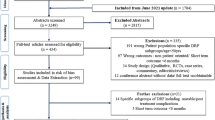Abstract
Introduction
Older patients with fragility fractures are not commonly tested or treated for osteoporosis. Compared to usual care, a previously reported intervention led to 30% absolute increases in osteoporosis treatment within 6 months of wrist fracture. Our objective was to examine longer-term outcomes, reproducibility, and cost-effectiveness of this intervention.
Methods
We conducted an extended analysis of a non-randomized controlled trial with blinded ascertainment of outcomes that compared a multifaceted intervention to usual care controls. Patients >50 years with a wrist fracture treated in two Emergency Departments in the province of Alberta, Canada were included; those already treated for osteoporosis were excluded. Overall, 102 patients participated in this study (55 intervention and 47 controls; median age: 66 years; 78% were women). The interventions consisted of faxed physician reminders that contained osteoporosis treatment guidelines endorsed by opinion leaders and patient counseling. Controls received usual care; at 6-months post-fracture, when the original trial was completed, all controls were crossed-over to intervention. The main outcomes were rates of osteoporosis testing and treatment within 6 months (original study) and 1 year (delayed intervention) of fracture, and 1-year persistence with treatments started. From the perspective of the healthcare payer, the cost-effectiveness (using a Markov decision-analytic model) of the intervention was compared with usual care over a lifetime horizon.
Results
Overall, 40% of the intervention patients (vs. 10% of the controls) started treatment within 6 months post-fracture, and 82% (95%CI: 67–96%) had persisted with it at 1-year post-fracture. Delaying the intervention to controls for 6 months still led to equivalent rates of bone mineral density (BMD) testing (64 vs. 60% in the original study; p = 0.72) and osteoporosis treatment (43 vs. 40%; p = 0.77) as previously reported. Compared with usual care, the intervention strategy was dominant – per patient, it led to a $13 Canadian (U.S. $9) cost savings and a gain of 0.012 quality-adjusted life years. Base-case results were most sensitive to assumptions about treatment cost; for example, a 50% increase in the price of osteoporosis medication led to an incremental cost-effectiveness ratio of $24,250 Canadian (U.S. $17,218) per quality-adjusted life year gained.
Conclusions
A pragmatic intervention directed at patients and physicians led to substantial improvements in osteoporosis treatment, even when delivered 6-months post-fracture. From the healthcare payer’s perspective, the intervention appears to have led to both cost-savings and gains in life expectancy.



Similar content being viewed by others
References
Physicians’ guide to prevention and treatment of osteoporosis. National Osteoporosis Foundation, 2002 (http://www/nof.org/physguide.html; last accessed on August 1st, 2006)
Scientific Advisory Council, Osteoporosis Society of Canada (2002) 2002 clinical practice guidelines for the diagnosis and management of osteoporosis in Canada. Can Med Assoc J 167[Suppl]:S1–S34
Andrade SE, Majumdar SR, Chan KA, Buist DS, Go AS et al (2003) Low frequency of treatment of osteoporosis among postmenopausal women following a fracture. Arch Intern Med 163:2052–2057
Feldstein A, Elmer PJ, Orwoll E, Herson M, Hillier T (2003) Bone mineral density measurement and treatment for osteoporosis in older individuals with fractures. Arch Intern Med 163:2165–2172
Majumdar SR, Rowe BH, Folk D, Johnson JA, Holroyd BH et al (2004) A controlled trial to increase detection and treatment of osteoporosis in older patients with a wrist fracture. Ann Intern Med 141:366–373
Siris ES, Bilezikian JP, Rubin MR, Black DM, Bockman RS et al (2003) Pins and plaster aren’t enough: a call for the evaluation and treatment of patients with osteoporotic fractures. J Clin Endocrinol Metab 88:3482–3486
Hajcsar EE, Hawker G, Bogoch ER (2000) Investigation and treatment of osteoporosis in patients with fragility fractures. Can Med Assoc J 163:819–822
Cuddihy MT, Gabriel SE, Crowson CS, Atkinson EJ, Tabini C et al (2002) Osteoporosis interventions following distal forearm fractures: a missed opportunity. Arch Intern Med 162:421–426
Eliot-Gibson V, Bogoch ER, Jamal SA, Beaton DE (2004) Practice patterns in the diagnosis and treatment of osteoporosis after fragility fracture: a systematic review. Osteoporos Int 15:767–778
Johnson JA, Eurich DT, Toth EL, Lewanczuk RZ, Lee TK, Majumdar SR (2005) Generalizability and persistence of a multifaceted intervention for improving quality of care for rural patients with type-2 diabetes. Diabetes Care 28:783–788
Mason J, Freemantle N, Nazareth I, Eccles M, Haines A, Drummond M (2001) When is it cost-effective to change the behavior of health professionals? JAMA 286:2988–2992
Johnell O, Jönsson B, Jönsson L, Black D (2003) Cost effectiveness of alendronate for the treatment of osteoporosis and prevention of fractures. Pharmaco-economics 21:305–314
Tosteson AN, Jonsson B, Grima DT, O’Brien BJ, Black DM, Adachi JD (2001) Challenges for model-based economic evaluations of postmenopausal osteoporosis interventions. Osteoporos Int 12:849–857
Schousboe JT, Nyman JA, Kane RL, Ensrud KE (2005) Cost-effectiveness of alendronate therapy for osteopenic postmenopausal women. Ann Intern Med 142:734–741
Klotzbuecher CM, Ross PD, Landsman PB, Abbott III TA, Berger M (2000) Patients with prior fractures have an increased risk of future fractures: a summary of the literature and statistical synthesis. J Bone Miner Res 15:721–739
Wiktorowicz ME, Goeree R, Papaioannou A, Adachi JD, Papadimitropoulos E (2001) Economic implications of hip fracture: health service use, institutional care and cost in Canada. Osteoporos Int 12:271–278
Cranney A, Guyatt GH, Griffith L, Wells G, Tugwell P, for the Osteoporosis Research Advisory Group (2002) Summary of meta-analyses of therapies for postmenopausal osteoporosis. IX. Endocrinol Rev 23:570–578
Tonino RP, Meunier PJ, Emkey RD, Rodriguez-Portales JA, Menkes CJ et al for the Phase III Osteoporosis Treatment Study Group (2000) Skeletal benefits of alendronate: 7-year treatment of postmenopausal osteoporotic women. J Clin Endocrinol Metab 85:3109–3115
Bone HG, Hosking D, Devogelaer JP, Tucci JR, Emkey RD et al for the Alendronate Phase III Osteoporosis Treatment Study Group (2004) Ten years’ experience with alendronate for osteoporosis in postmenopausal women. N Engl J Med 350:1189–1199
Thomson MA, Oxman AD, Haynes RB (2005) Local opinion leaders to improve health professional practice and health care outcomes. The Cochrane Library. The Cochrane Database of Systematic Reviews, Issue 4
Alberta Health Care Insurance Plan (2004) Schedule of medical benefits (procedures and price list). Alberta Health and Wellness, Edmonton, Alberta, Canada
Alberta Health and Wellness (2004) Drug benefits list. Edmonton, Alberta, Canada
Alberta Health and Wellness (2003) Health Costing in Alberta – Annual Report. Edmonton, Alberta, Canada
Canadian Institute for Health Information (2003) Resource intensity weights and expected length of stay. Ottawa, Ontario, Canada
Statistics Canada (2002) Life tables-Canada, provinces and territories, 1995–1997 (84-537-XIE). Ottawa, Ontario, Canada
Jiang HX, Majumdar SR, Dick DA, Moreau M, Raso J et al (2005) Development and initial validation of a risk score for predicting in-hospital and one-year mortality in patients with hip fractures. J Bone Miner Res 20:494–500
Donaldson C, Currie G, Mitton C (2002) Cost effectiveness analysis in healthcare: contraindications. Br Med J 325:891–894
Higashi T, Shekelle PG, Adams JL, Kamberg CJ, Roth CP et al (2005) Quality of care is associated with survival in vulnerable older patients. Ann Intern Med 143:274–281
Cooper C, Atkinson EJ, Jacobsen SJ, O’Fallon WM, Melton LJ 3rd (1993) Population-based study of survival after osteoporotic fractures. Am J Epidemiol 137:1001–1005
Center JR, Nguyen TV, Schneider D, Sambrook PN, Eisman JA (1999) Mortality after all major types of osteoporotic fracture in men and women: an observational study. Lancet 353:878–882
Acknowledgements
This investigation was supported by grants from the Medical Services Budget Innovation Fund (Alberta Medical Association Medical and Alberta Health and Wellness) and the Alberta Heritage Foundation for Medical Research. Dr. Majumdar is a Population Health Investigator, Dr. Johnson is a Health Scholar, and Dr. Maksymowych is a Senior Scholar, all of the Alberta Heritage Foundation for Medical Research; Dr. Majumdar is a New Investigator of the Canadian Institutes of Health Research; Drs. Rowe and Johnson hold Canada Research Chairs. The authors would like to acknowledge the substantial efforts of other members of the research team – Charles Harley, MD; Brian Wirzba, MD; Debbie Bellerose, RN – who made important contributions to this and earlier work. The authors also thank the Orthopedic Plaster Room Technicians at the University of Alberta Hospital and the Royal Alexandra Hospital for their time and efforts for the study and the Epidemiology Coordinating and Research (EPICORE) Centre of the University of Alberta for providing services related to trial coordination and data management. Finally, the authors dedicate this work to the memory of Deb Folk, RN, our project coordinator, who was not able to see the final study results published. Without her enthusiasm and tireless efforts on our behalf, this study would not have been possible.
Author information
Authors and Affiliations
Corresponding author
Additional information
Role of the funding sources: The study was funded by peer-reviewed grants from the Alberta Medical Association, Alberta Health and Wellness, and the Alberta Heritage Foundation for Medical Research. The funding sources had no role in the design and conduct of the study, the collection, analysis, or interpretation of the data, or the decision to submit the manuscript for publication.
Trial Registry: NCT00175214
Rights and permissions
About this article
Cite this article
Majumdar, S.R., Johnson, J.A., Lier, D.A. et al. Persistence, reproducibility, and cost-effectiveness of an intervention to improve the quality of osteoporosis care after a fracture of the wrist: results of a controlled trial. Osteoporos Int 18, 261–270 (2007). https://doi.org/10.1007/s00198-006-0248-1
Received:
Accepted:
Published:
Issue Date:
DOI: https://doi.org/10.1007/s00198-006-0248-1




